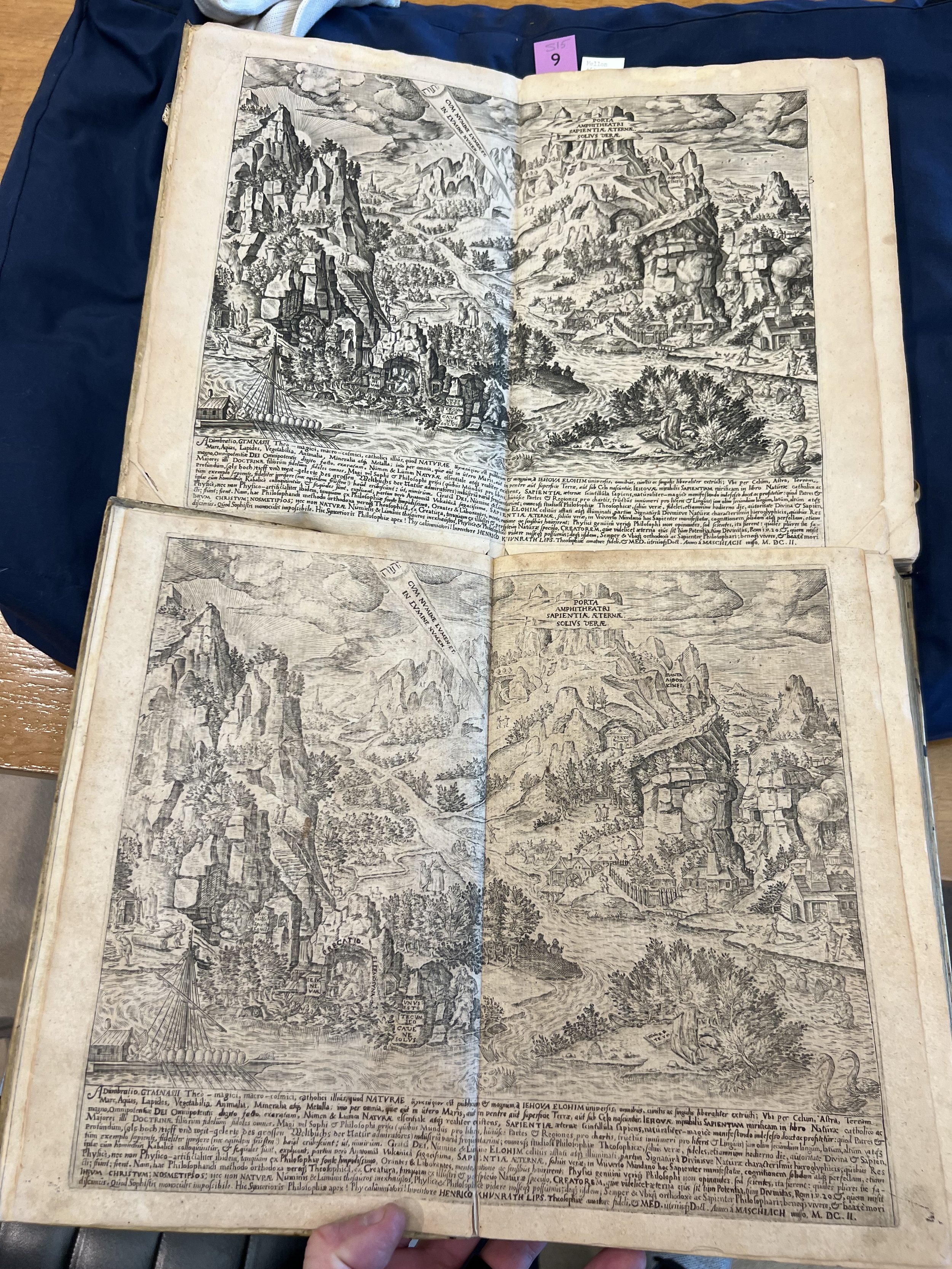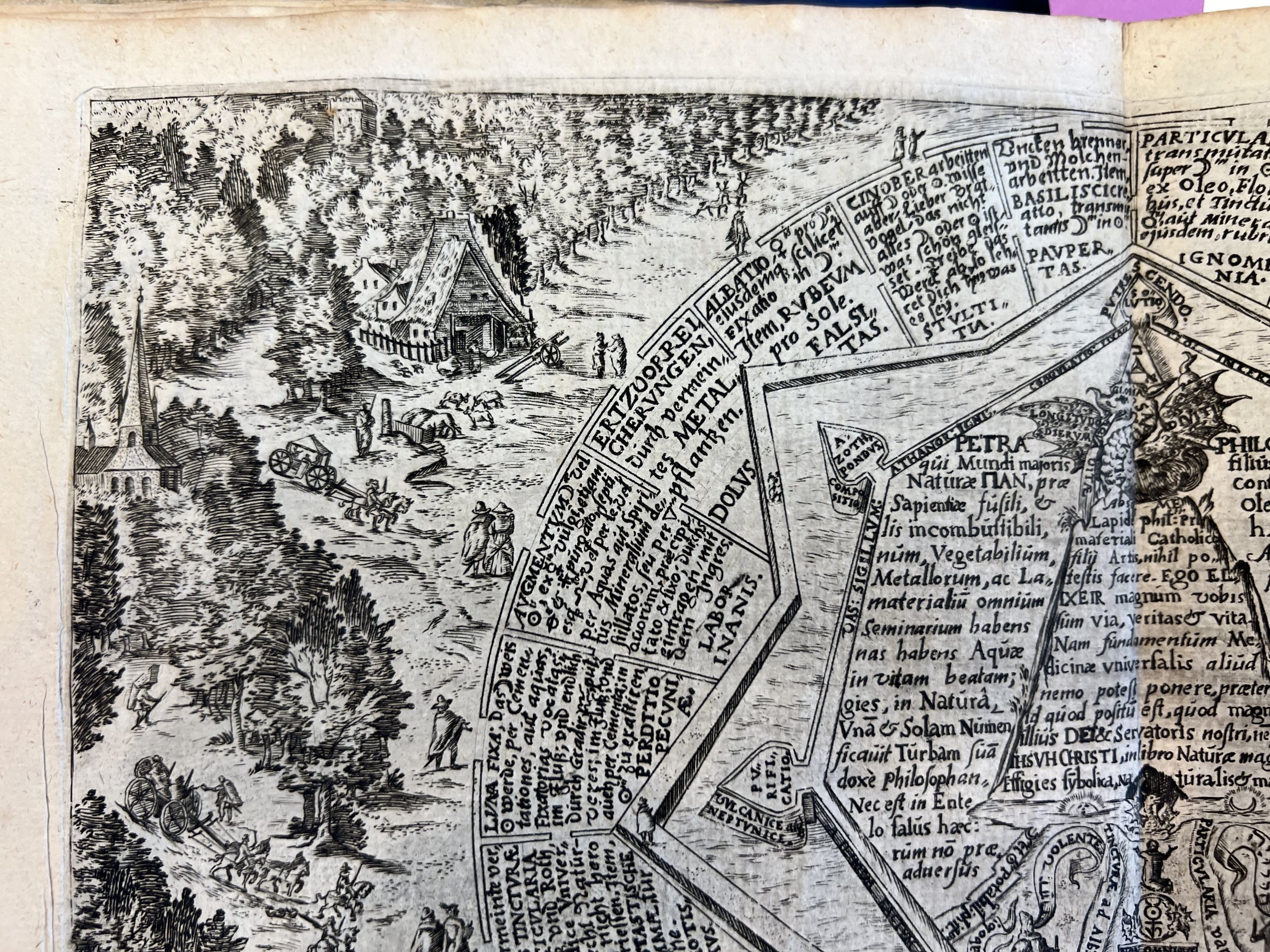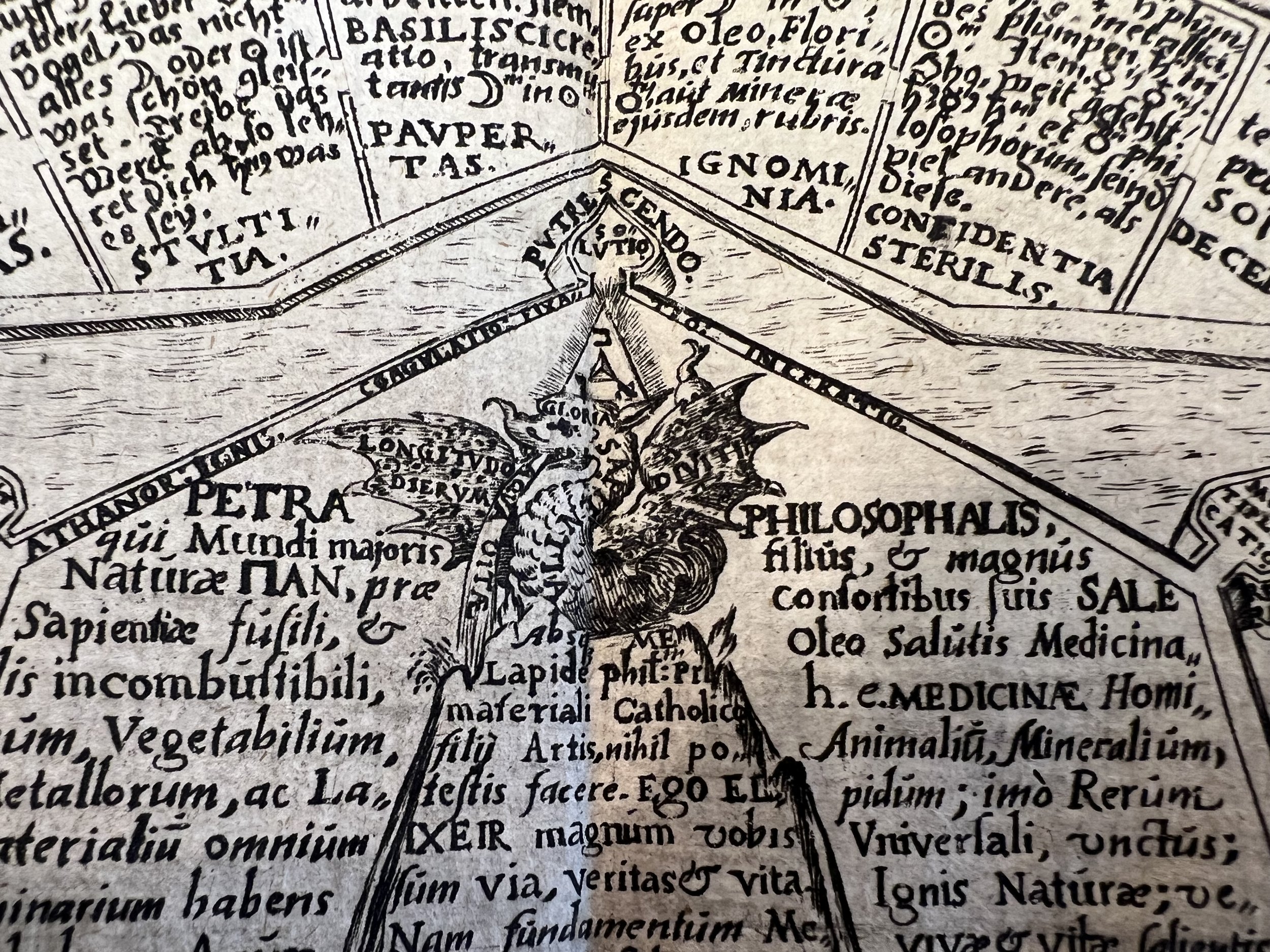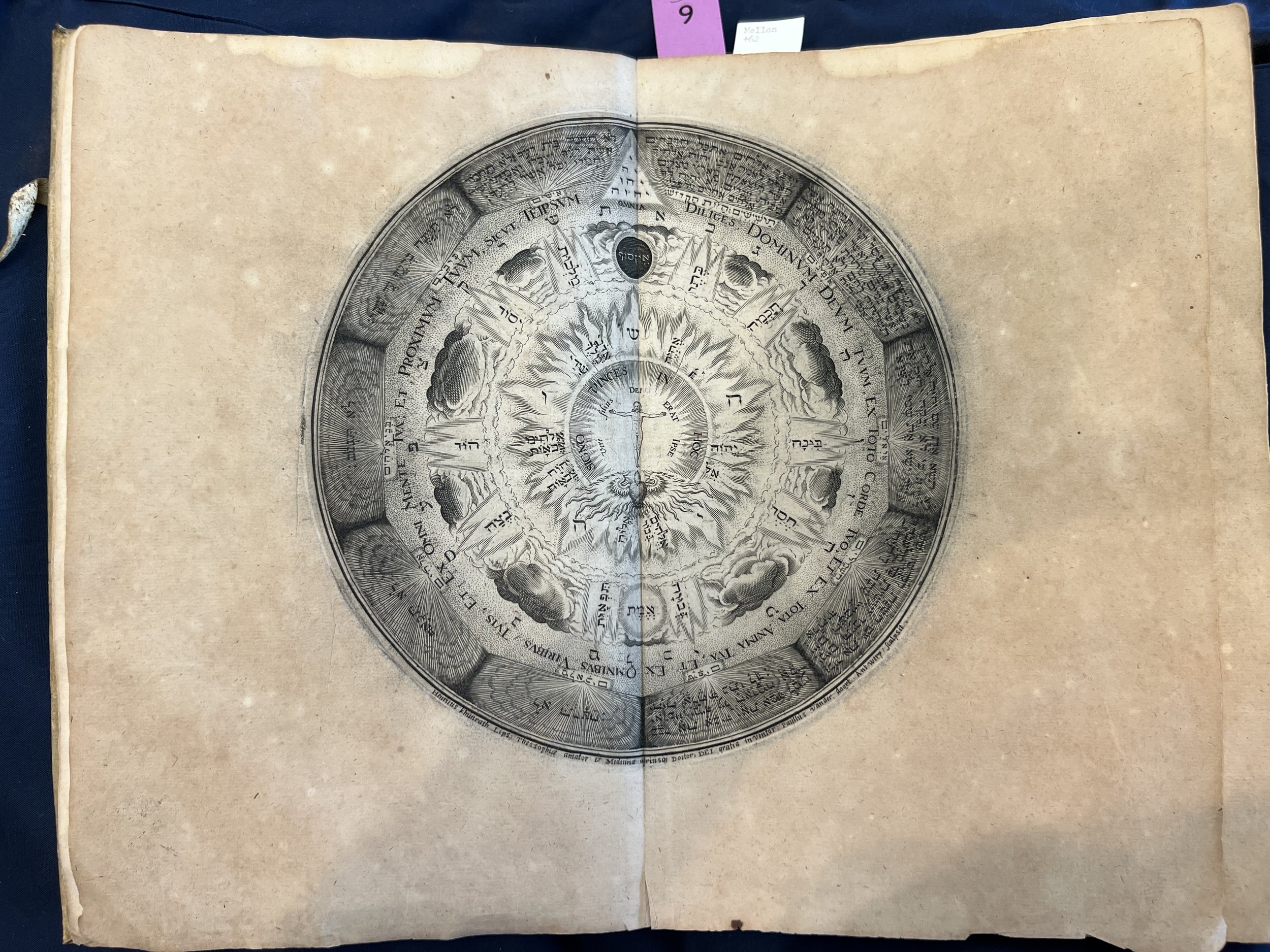Amphitheatrum Sapientiae Aeternae
Amphitheater of Eternal Wisdom
Mellon 62




Although Giovanni Pico della Mirandola (1463–1494) is often considered “the first among Latin scholars to refer directly to the kabbalah”, Khunrath was familiar with Pico’s work, but was far more influenced by the German humanist Johann Reuchlin (1455–1522), who was “one of the key figures of European scholarship and intellectual life at the turn of the sixteenth century.”
The presence of Reuchlin’s wonder-working Christian-Cabalist name of Christ, IHSVH, at the conclusion of Khunraths 1588 theses proves that Khunrath was already influenced by Reuchlin’s work in his twenties, long before the publication of the Amphitheatre.
Reuchlin, known for his prominent works in Christian Cabala, authored the influential books De verbo mirifico (On the Wonder-Working Word, 1494) and De arte cabalistica (On the Cabalistic Art, 1517). While Pico and Reuchlin explored the use of Cabalistic methods to persuade Jews about Christianity, they never directly addressed a "Christian" Cabala. The concept was later introduced in the unpublished Traité de la Cabale or Traité de la Cabala chrétienne (Treatise on the Cabala or Treatise on Christian Cabala, c.1521) by the French monk Jean Thenaud (1480–1542). Jean Thenauds work remained in manuscript. Thus it is the case that Khunrath’s 1609 Amphitheatre is the first published work explicitly described as “Christian Kabbalist” (Christiano-Kabalisticum).
Khunrath describes this figure as the Sigillum Dei (“Seal of God”) or Sigillum Emes (“Seal of Truth”), which of course allude to Christ’s declaration in John 14:6: “I am the way, and the truth, and the life,” but also hold great significance for scholars of the English magus John Dee (1527–1608/9). Khunrath met Dee in Bremen in 1589, while the latter was returning home from several years spent on the Continent, performing many “Actions with Spirits” with his scryer Edward Kelley (1555–c.1597) and their own Sigillum Dei. With this, we connect with Khunrath’s second neologism on the 1609 title page, Divino-Magicum (Divinely Magical).
As we mentioned in the first episode, that many alchemical works relied/influenced by Dee’s Monas hieroglyphica and one of those was the Amphitheatrium Sapientia; And having the three sacred languages as well as using Pythagorean neoplatonic, and Kabbalah, is one piece of evidence on how scholars attribute this link. Another example of the link between Dee and Khunrath is that in the Amphitheater we see the totality of overlap between magic and alchemy. However, with Khunrath, a majority of the work is laboratory based.
Some of the art engravings are part of art teaching curriculums by art historians.
In the Amphitheatre, Khunrath elaborates on the concept of “physical” and “hyperphysical” magic, delving into practices that are both natural and supernatural. It is evident that he is well-versed in the contemporary natural magic pioneered by the renowned Italian natural philosopher, Giovanni Battista Della Porta (1535–1615). Additionally, Khunrath demonstrates his familiarity with the diverse forms of magic discussed in Heinrich Cornelius Agrippa’s De occulta philosophia (1533) and Theophrastus Paracelsus’s Astronomia Magna (1537–38).
While physical magic deals with bodies and spirits in the sense of sensible animating principles of life, hyperphysical magic means for Khunrath “pious and useful conversation, as much when awake as when sleeping, mediately and immediately, with GOD’S fiery ministers, the good angels.”
Khunrath's fascination extends to Theomagia, emphasizing divine magic. He introduces the term, later used by Welsh alchemist Eugenius Philalethes in Anthroposophia Theomagica (1650) and John Heydon in Theomagia, or the Temple of Wisdome (1663).
Point on Physical Magic - The opening page Amphitheater, Khunrath begins by describing physical chemistry and also describing Christian Kabbalah - which you just mentioned and we mentioned on Part I that he's actually the first person to explicitly use that term Christian Kabbalah even though some have traced it back to Pico della Mirandola and Agrippa, it was Khunrath that used it explicitly, and this is also the case with the phrase ‘Divine magic’.
Mellon 62 Compared to Mfd35 K529 +Am72
Khunrath was undoubtedly familiar with Agrippa’s epistolary exchange with his fellow German occult philosopher, abbot Johannes Trithemius. Their discourse delved into the degenerated status of magic and proposed ways to reinstate it to a respectable standing within the Christian world. This interaction likely influenced Khunrath's own views and pursuits in the realms of occult philosophy and esoteric practices.
Agrippa, considered one of Khunrath’s most esteemed sources, offers valuable insights into Khunrath’s concept of “Divino-Magicum” in his work De incertitudine & vanitate scientiarum (On the Vanity and Uncertainty of the Sciences, 1531). In this text, Agrippa draws parallels between divine magic and theurgy as discussed by renowned Neoplatonist philosophers Porphyry (c.234–c.305) and Iamblichus (c.245–c.325). According to Agrippa, theurgy enables individuals to attune their souls to commune with spirits, angels, and even perceive the divine presence of God.
In the year 1595, Heinrich Khunrath of Leipzig, a 35-year-old individual known as the "Doctor of both Medicines and faithful Lover of Theosophy," expressed his fascination with Cabala, magic, and alchemy within the initial publication of the Amphitheatre. Through the unique circular "Theosophical Figures," Khunrath presented his belief in the divine wisdom encompassed in the "Three Books" of God, Man, and Nature. He highlighted the importance of Cabala, magic, and alchemy as essential tools of Wisdom, along with the fundamental need for prayer within the oratory and practical work within the laboratory.
The plate commonly referred to as the Great Work, I believe is much more commonly referred to as the The Alchemists Laboratory, literally symbolizing a physical laboratory, for the most part serves to encapsulate Khunrath’s philosophy as a whole. Especially, in particular the engraving is “framed” as the search for the Prima Materia of alchemy that will lead to “eternal Christian wisdom”.
Indeed, the Amphitheatre’s full title contains three neologisms, the compound words Christiano-Kabalisticum, Divino-Magicum, and Physico-Chymicum (“Christian Kabbalist,” “Divinely Magical,” and “Physico-Chymical”).
These neologisms are to be understood together as part of a grand system already foreshadowed in his major work on magic in relation to alchemy, De Igne Magorum Philosophorumque (On the Fire of the Mages and Philosophers, 1608), where Khunrath declares not only the reciprocity and interconnectedness of his three practices, but his utter conviction that “KABALA, MAGIC and ALCHEMY conjoined, should and must be used together with and alongside one another.”
Apparently dissatisfied with existing alchemical terminology, such as the classical Greek chrysopoeia (the Art of gold-making), or the Paracelsian neologism spagiria (the Art of separating and reuniting), Khunrath invents the neo-Latin copulative compound Physico-chemicus.
In his first title, containing the compound physico-chymicus, the inventive Khunrath was only warming up for the triple hurdle he was to take in his title of 1609: “Amphitheatrum sapientiae aeternae, solius, verae; Christiano-Cabbalisticum, divino-magicum, physico-chymicum, ter-triunum catholicum.”
Mellon 62 Compared to Mfd35 K529 +Am72
The first two compound words on the 1609 title page, Christiano- Kabalisticum and Divino-Magicum (hybrids of Latin and Hebrew, and Latin and Greek, respectively), express the interdisciplinary conjunctions and combinations in Khunrath’s oratory and laboratory.
The title page drives this message home in various ways. Firstly, the foundations of the two Egyptian obelisks bear the famous message of mutuality and reciprocity from the Emerald Tablet of Hermes Trismegistus:
“Id quod inferius sicut quod superius” (“That which is below is like that which is above”). Secondly, the work is polyglot, including words in Latin, Greek, and Hebrew, and thirdly, the Pythagorean Tetraktys.
Khunrath modified his description of Wisdom’s three handmaids between the two editions of the Amphitheatre (the second edition appearing posthumously in 1609). In the 1595 edition they appear on the title page as Cabala, Mageja, and Alchemia, with Alchemia being glossed a few lines further down as Physicochemicum. Khunrath explicitly states that the theosopher is required to be a “greatly experienced and expert manual practitioner in the works of Physical Chemistry.”
Khunrath, Amphitheatrum (1609), Title Page containing the divine Hebrew name IHVH at the top of the image is echoed by the triangular mound at the base, with the signs for Khunrath’s three main protagonists in the generation of the Philosophers’ Stone (Sol, Luna, and Mercurius).
The Amphitheatre’s “Theosophical Figures,” which remain the same between the two editions, save for one or two minor changes, seem to follow the title’s sequence: certainly Figure 1 of Christ Cruciform primarily focuses on Christian Cabala, while Figure 3 of the Rebis or Hermaphrodite addresses Physico-Chemical alchemy.
The image of Adam Androgyne, gives us a first intimation of how Khunrath relates these two disciplines, for it references both Cabala and alchemy, with the distinct sense that man as theosopher is the divinely magical conduit between the two activities. The fourth and final, best-known figure summarizes the totality of Khunrath’s theosophical work with a scene that shifts from the two- dimensional representation of the preceding images to an impressive deeply perspectival image of the adept at work.
The Amphitheatre’s second, enlarged edition of 1609 features a notable addition of five rectangular 'hieroglyphic figures', alongside Khunrath's portrait and a symbol-rich title-page dated back to 1602. This edition also includes an owl engraving found in two other works by Khunrath. Three of the five double-page rectangular engravings credit Khunrath as the 'Inventor', 'Constructor', and 'Fashioner'. Khunrath's portrait reveals the engraver to be Johann Diricks van Campen, who created it in Magdeburg when Khunrath was 42 years old.
While not definitive, similarities in lettering suggest that these new images were likely crafted by the same artist. Unlike the 1595 edition, the engravings in this edition are in black and white, including the four circular engravings now presented without their original accompanying Isagoge or 'Introductory Commentaries'. This change was made to align with the smaller and more standardized folio format of the enhanced edition.
A curious fact about the copies of the 1609 Amphitheatre is that they all have the engravings bound in different sequences. It is doubtful whether any real order was ever intended for the later rectangular engravings; in fact, an errata note in the colophon asks readers to ignore the printer’s mistaken instructions to insert images at the end of each of the book’s 7 Grades.
In the Amphitheatre we find several calls for the restorative and renewing reformation of magic and the extirpation of Nigromancy (i.e., necromancy). This indeed is a major message of the Oratory Laboratory engraving.
Mellon 62 Compared to Mfd35 K529 +Am72
Mellon 62 Compared to Mfd35 K529 +Am72
Mellon 62 Compared to Mfd35 K529 +Am72
Where we see the word ‘Azoth’, there is Dee’s Monas glyph forming the ‘O’ in ‘Azoth’ inside the belly of the bird. In the previous episode, Nick mentions this is best described in Basil Valentines work: First & last letters of the 3 biblical scriptural languages: Azoth is formed from (1) Latin A and Z, (2) Greek A (alpha) and Ω (omega) and (3) Hebrew א (aleph) and ﬨ (tau). Also, on the ‘O’, is the sun symbol, which is also the Pythagorean symbol. Also associated with the Sun is gold and the emerging adage the SON is the Sun.
The Monas glyph also contains a representation of all 7 alchemical planets, as well as the electromagicum stemming from Paracelsus doctrines. The theme of the number 3 is represented here with the Bird + Word + Glyph
Azoth had much significance to the alchemist of that time for it represented the alchemical change from prima materia to the final or ultima materia. Azoth is also believed to be the animating energy of the body & the enthusiasm that moves the mind; the mysterious evolutionary force that drives the physical and moves the spiritual towards perfection - ‘Light of Nature’ or the Mind of God. The ‘Light of Nature’ or the ‘Mind of God’ is also terminology Khunrath uses in Lux in Tenebris.
Azoth is the essential agent of transmutation in alchemy. Etymology traces Azoth to medieval Latin as a modification for “azoc” which was derived from the Arabic word meaning, ‘the mercury’. Azoth also appears on or seen on Paracelsus’ pummel of his sword.
Moving down the image, Sun/sulfur/Gold are the masculine elements seen on the left side whereas on the right, the moon/mercury/silver is depicted which are the female elements. In the center of the body, the word ‘Reubis’ is written on the upper abdomen area (ribs) and liquid is seen coming out of this center part almost like a fleur de lis, similar to aqueous humor in the eye. Words are written in the liquid streaming out in the form of mirror writing - a style that was commonly used by Leonardo di Vinci - perhaps to give an illusion of mirrored self. On the left side, the words translate to ‘Pure blood of the lion facing East’; on the right side, ‘Gluten of the Eagle facing West’. These words are a modified quote from Tincture of Natural Philosophers by Paracelsus.
Sulphur, Salt and Mercury are the 3 glyphs appearing like tattoos on the front of the body, continuing the theme of Paracelsian theory.
The human figure is holding what looks like a stone or egg with the symbol of philosopher's stone in the center. The figure is holding it over their groins or reproductive organs, bringing to mind that instead of a fig leaf - which could be an association of being ashamed of nakedness - the Philosopher's Stone is emanating forth. The Androgyne brings forth an egg, a cosmic egg. The theme of 3 is again represented: Soul/Sulphur + Spirit/Mercury + Body/Salt. As a side note, the association of salt with the body reminds me notion of containing entities with of keeping entities out.
Mellon 62 Compared to Mfd35 K529 +Am72
Mellon 62 Compared to Mfd35 K529 +Am72
Plate - Cosmic Rose - Sigillum Dei
The Seal of God with Christ as his first almost to signify that is what you should focus on first. Christ is at the center and is surrounded by Hebrew-derived names which are emanations of the deity of the sephiroth of the Kabbalah or tree of life and on the outer portion of the plate are the 10 commandments in Hebrew. This would represent Khunrath’s Christian Kabbalah to illustrate a recognition of God through Christian Kabbalah prayer.
Plate - Macro-Microcosmic unity
Meant to represent Adam and Eve before they were separated and definitely, pre- Fall.
Know thyself through Divine Magic = microcosm to the macrocosm.
Almost like Philosopher’s stone symbol = circling the square = circle, square, triangle
Surrounding the square are the 4 elements with alchemical language.
Plate - Philosopher’s Stone
The Androgyne is ubiquitous throughout all the ancient esoteric and occult philosophies and regarded in higher regard than either of the individual genders as it symbolizes wholeness or completion and thus perfection. In Eliphas Levi’s description under the Baphomet illustration, Levi references the arms in Khunrath’s Adam Androgyne are the same ones in his Baphomet - One arm is female and the other male.
The edges of this plate begins with what is the Philosopher's Stone. We also see how he combines the same 3 languages did in Monas, Greek, Latin, and Hebrew. The tetractys of Pythagoras is also included here.
In regards to the bird used here, it is the alchemical bird represented as a chimeric version of raven, peacock, some say swan and phoenix. We also see the rainbow phase of physical alchemy.
Plate - Alchemist’s Laboratory…
In this plate, Khunrath takes us into the space of where an Alchemist, a physical alchemist, a physical chemist would spend his time running alchemical experiments. I personally really love this plate because I feel it genuinely illustrates all 3 elements of complete alchemy.
On the left side of the room, we see a curtain over a space that is reserved for prayer and/or mediation. Which is clearly what the artist is signifying by showing a man (possibly Khunrath) kneeling before an altar. The way that the curtain is set up over the altar reminds me of a tabernacle, rather what i am familiar with is the tabernacle that is present in Catholic Church.
At the top of this structure, it is written, “This is all” .. which reminds me of what Pythagoras said, “Number is all”. Below , “Happy is he who follows the advice of Jehovah”. And below that is an inscription in Hebrew that translates to “Wisdom of God”. On the side of the tent - “When we attend to our work, God will assist us”.
Inside the curtain/tent, a plaque is found to contain the Latin words, “do not speak of God without Light” with a lamp shining light in front of it. Again, we’ve said it multiple times in many episodes about the association of Light, sunlight in regards to the eye-pineal-consciousness association.
On the altar, two books can be seen. A Bible on the right side opened to Book of Psalms 14:5, which when you look it up says, “Then they were in great Terror for God was with the righteous generation”. Nick has continuously brought up the Book of Psalms and it’s possible significance. The book on the left is a book with symbols denoting Khunrath’s circular plates from his Amphitheatre. Looking at Khunrath’s symbols in this plate, reminds me of a viewer looking into a window or mirror looking into a window/mirror continuously.
Under the altar, on the support structure we see written, “Learn well from dying”. Again, Nick has spoken at length about dying and the association of it with potentially crossing the abyss. But this quote is almost as a way to say, learn as a student learns of what dying can reveal. Also, some scholars indicate that this could mean awareness can come through contemplating death.
Off to the left side of the altar, smoke is coming off incense burning and words written inside the smoke translated say: “Prayer rises like smoke, sacrifice agreeable to God”
On the right hand side of the plate is the entire laboratory with on the far right a source of fire, ovens or chimney adorned with flasks and glassware associated with lab work. Between the 2 columns supporting the chimney, a coat of arms sits atop with an inscription of “Neither Rashly nor Timidly”. Along the moulding is written, “That which is wisely tried again will sometimes succeed”. On the side of the chimney, flasks are kept and some of the flasks have labels on them, one you can see has the symbol for mercury. Some others might contain Hyle, Azoth, etc. These chemicals are found to be the source materials needed in practicing physical alchemy.
On the floor a basket with coals reads, “Do not hold back from using coals”.
Closer in, three different furnaces can be seen. On the left, is the alembic with its receiver used for distillation, which was covered when Nick discussed Mary the Jewess. In the middle is a tall furnace used as a heat source with the words: “Fistina lente” , translated to “The more haste, the less speed” which is reminiscent of dualism. To the right of the othe two, is a box containing more lab glassware that looks like the reagents inside are reaching a state of boiling with bubbles drawn inside the liquid.
On top of the center island or table are musical instruments with an inscription on the tablecloth: “sacred music makes sadness/bad spirits fly away, spirit of Jehovah sings happily in a heart filled with holy joy.”
Towards the back of the table, on the side of where a chair is visible, writing tools are found on the left corresponding to the mental aspect, with scales plus mortar and pestle are found on the right, corresponding to lab work. Hence, the books depict spiritual alchemy and lab equipment depicts physical alchemy.
In the far back of the image, to the left is a bed or the alchemist's bed. Next to it, a door opened, leading outside of the lab. At the top is written: “be vigilant even when asleep”.
At the very top of the plate is a light source in the form of a chandelier that has 7 candles burning supported by a structure that looks like a 7-pointed star. Diving into the 7-pointed star, or the Heptagram, it can serve as an interpretation of a bridge between worlds or realms. Also, Alchemists used the 7 pointed star to represent the 7 elements of the world as well as the 7 planetary metals, Christians have used the star to represent the 7 days of creation.
Written on top: “No man can be great without Divine inspiration”.
A scholar wrote this about Khunrath and I think it's fitting here:
“For Khunrath, alchemy could only be pursued by uniting the inner spiritual struggle for closeness to the Divine WITH the outer experiments of laboratory work and the 2 brought together in harmony like music composition. Contemplation and prayer were as essential a part of the work like pouring over crucibles and feeding ones furnaces with coals.”



























































